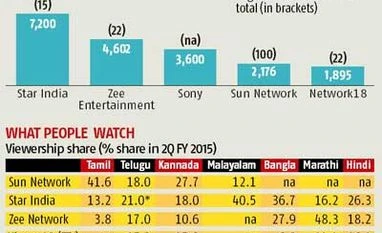A partial explanation is that perhaps there couldn't be a better time for Star to go for the jugular. The deal gives the Indian subsidiary of Rupert Murdoch's $32-billion 21st Century Fox a huge leverage in its bid for the southern market just when Kalanithi Maran's Sun Network, by far the biggest player in the region, is at its weakest. Sun's ad revenues are under pressure, say analysts. From over 16 per cent in 2008, the Sun network's audience share, defined as a percentage of time Indians spend watching TV, has fallen by half. In state after state in south India, the Rs 2,176-crore Sun Network is losing ground.
In Kerala, Star India dominates the market with Asianet, a network it bought in 2008 at about the same price as Maa TV. The acquisition gave Star India, among other channels, the Kannada language Suvarna. It has used Suvarna to wrest market share from Sun TV's Udaya in Karnataka. In Andhra Pradesh, Maa TV has been on the rise for more than two years now. In the last quarter of 2014, Maa TV overtook Sun's Gemini TV to become the leader in the Telugu-speaking state. Except for Tamil Nadu, where Sun TV is still the leader, Star India has a strong regional portfolio with leading or number two positions in Marathi, Bangla, Telugu, Kannada and Malayalam.
Uday Shankar, CEO, Star India, dismisses the Star versus Sun argument: "The competitive landscape was not a factor that played out in our decision. It (Andhra Pradesh) was a key market that had always been on our radar. In all the four (southern) states we now have a significant share. "
He points out that sports and regional markets were the two big growth planks he pitched for when he joined Star as CEO in 2007. While the Asianet acquisition happened soon after, in 2008, other investments got held back as the global economy slowed and the India sentiment weakened. "The only external factor to influence our decision is the change in sentiment that the new government has brought," says Shankar.
"When Star bought Asianet, it paid a lot. But the acquisition paid off because regional drives more than 40 per cent of the profitability at Star," points out Vivek Couto, executive director, Media Partners Asia, a Hong Kong-based consulting firm. With Maa TV, "Star is now a national network with offerings for audiences across the country," says K Satyanarayana, senior vice-president, R K Swamy Media Group.
This, however, is not about cutting costs by selling dubbed content. "The driver for this kind of consolidation is not scale. The value of a regional business is diversity, not uniformity," adds Anuj Poddar, project head of ETV Marathi, ETV Gujarati and executive vice-president Viacom18 TV. Subhash Chandra's Zee Entertainment is already a significant player in all the languages that Star is present in and more.
The ripple effect
That brings us to the second major implication of the deal. The battle for dominance over non-Hindi or regional markets is now going to be fought between Star, Zee and Viacom18. Sun TV will need to ally or merge with a bigger Hindi force if it is to remain relevant, say analysts. The non-Hindi language market, which gets roughly 27 per cent of the audience time, accounted for 30 per cent of the Rs 43,000 crore in revenues that television made in 2013.
"Earlier Hindi channels substituted for all markets except the four southern states," says Satyanarayana. Now, as each language market comes into its own, a wider footprint is becoming critical. Each of the three big networks gets anywhere between 15 and 25 per cent of their top line from non-Hindi markets. That changes the dynamics of the industry.
Most broadcasters commission programming and market the airtime on it themselves. Sun TV sells half hour slots to programme producers for a fee. This brings in a steady cash flow while other broadcasters have to wait for 60-90 days before advertisers pay up. But it leaves the market open to price cutting as producers, who double as airtime sales people, slash rates to compete with each other. It sends mixed signals to advertisers who are dealing with Sun TV through different people.
The third implication is on costs. Fiction costs in regional markets have held steady at Rs 70,000 to Rs 1,10000 for a half-hour episode for years. As the three big networks compete, these could go up. Most format shows, however, could see lower costs per channel as licence fees get written off across different languages - for instance, Big Boss, which made its debut on Colors, is now on the network's Bangla and Kannada channels.
If the Maa acquisition is a blow to Sun's dominance in south India, a possible merger between Sun and Sony could be a blow for Star, say analysts. While both Sun and Sony were not available for comment, Sony has been eager to expand its regional footprint and even tried, unsuccessfully, to acquire Maa two years ago. Sun has indicated that it will spend more on fiction and focus on markets like Andhra Pradesh and Karnataka where the slide in its audience share has been dramatic. Maran is a doughty fighter who has built a robust broadcasting business just by understanding what his audience wants. All it might take for Sun to bounce back is some attention from its promoter.
)